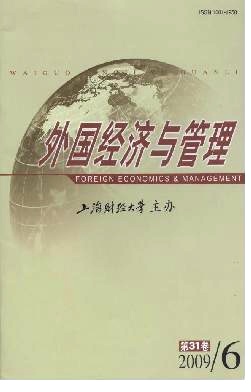风险性消费活动研究综述
外国经济与管理 2009 年 第 31 卷第 06 期, 页码:39 - 44
摘要
参考文献
摘要
本文从风险性消费活动的起因、消费者参与风险性消费活动的情感体验及风险性消费活动的影响后果三个方面对相关研究进行了分析和总结,以期实现与传统理论的融合,最后指出了今后的研究方向。
[1]Wood,C M,and Scheer,L K.Incorporating perceived risk into model of consumer deal assessment and purchase intent[J].Ad-vances in Consumer Research,1996,23(1):399-404.
[2]Celsi,R L,Rose,R L,and Leigh,T W.An exploration of high-riskleisure consumption through skydiving[J].Journal of ConsumerResearch,1993,20(6):1-23.
[3]Andrade,E B,and Cohen,J B.On the consumption of negative feelings[J].Journal of Consumer Research,2007,34(3):283-300.
[4]Davidson,RJ.Affective style and affective disorders:Perspectives fromaffective neuroscience[J].Cognition and Emotion,1998,12(3):307-330.
[5]王振宏,郭德俊.情感风格及其神经基础[J].心理科学,2005,28(3):751-753.
[6]Zuckerman,M.Sensation seeking:Beyond the opti mal level of arousal[M].Hillsdale,NJ:Erlbaum,1979.
[7]Fenz,WD,and Epstein,S.Gradients of physiological arousal in parachutists as a function of an approachingjump[J].PsychosomaticMedicine,1967,29(Jan./Feb.):33-52.
[8]Park,C W,and Lessig,VP.Students and housewives:Differencesin susceptibility to reference groupinfluence[J].Journal of Con-sumer Research,1997,9(1):102-110.
[9]Belk,R R,Melanie,W,and John,F S.The sacred and profanein consumer behavior:Theodicy onthe odyssey[J].Journal of Con-sumer Research,1989,16(Jun.):1-38.
[10]Myers,D G,and Hel mut,L.Group polarization phenomenon[J].Psychological Bulletin,1976,83(Jul.):602-627.
[11]Andrade,E B.Behavioral consequences of affect:Combining evaluative and regulatory mechanisms[J].Journal of Consumer Re-search,2005,32(Dec.):355-362.
[12]Watson,D,Clark,L A,and Tellegen,A.Development and validation of brief measures of positive and negative affect:The PA-NAS scales[J].Journal of Personality and Social Psychology,1988,54(6):1 063-1 070.
[13]Russell,J A,and Carroll,J M.On the bipolarity of positive and negative affect[J].Psychological Bulletin,1999,125(1):3-30.
[14]Schi mmack,U.Pleasure,displeasure,and mixed feelings:Are semantic opposites mutually exclusive?[J].Cognition and Emo-tion,2001,15(1):81-97.
[15]Larsen,J T,McGraw,A P,and Cacioppo,J T.Can people feel happy and sad at the same ti me?[J].Journal of Personality andSocial Psychology,2001,81(4):684-696.
[16]Williams,P,and Aaker,J L.Can mixed emotions peacefully coexist?[J].Journal of Consumer Research,2002,28(4):636-649.
[17]Lau-Gesk,L.Understanding consumer evaluations of mixed affective experiences[J].Journal of Consumer Research,2005,32(1):23-28.
[18]Solomon,R L.The opponent process theory of acquired motivation:The costs of pleasure and the benefits of pain[J].AmericanPsychologists,1980,35(Sep.):691-712.
[19]王欢,郭玉锦.网络社区及其交往特点[J].北京邮电大学学报(社会科学版),2003,5(4):19-21.
[20]迈克尔.R.所罗门,卢泰宏.消费者行为学[M].(第6版).北京:电子工业出版社,2006:553-554.
[2]Celsi,R L,Rose,R L,and Leigh,T W.An exploration of high-riskleisure consumption through skydiving[J].Journal of ConsumerResearch,1993,20(6):1-23.
[3]Andrade,E B,and Cohen,J B.On the consumption of negative feelings[J].Journal of Consumer Research,2007,34(3):283-300.
[4]Davidson,RJ.Affective style and affective disorders:Perspectives fromaffective neuroscience[J].Cognition and Emotion,1998,12(3):307-330.
[5]王振宏,郭德俊.情感风格及其神经基础[J].心理科学,2005,28(3):751-753.
[6]Zuckerman,M.Sensation seeking:Beyond the opti mal level of arousal[M].Hillsdale,NJ:Erlbaum,1979.
[7]Fenz,WD,and Epstein,S.Gradients of physiological arousal in parachutists as a function of an approachingjump[J].PsychosomaticMedicine,1967,29(Jan./Feb.):33-52.
[8]Park,C W,and Lessig,VP.Students and housewives:Differencesin susceptibility to reference groupinfluence[J].Journal of Con-sumer Research,1997,9(1):102-110.
[9]Belk,R R,Melanie,W,and John,F S.The sacred and profanein consumer behavior:Theodicy onthe odyssey[J].Journal of Con-sumer Research,1989,16(Jun.):1-38.
[10]Myers,D G,and Hel mut,L.Group polarization phenomenon[J].Psychological Bulletin,1976,83(Jul.):602-627.
[11]Andrade,E B.Behavioral consequences of affect:Combining evaluative and regulatory mechanisms[J].Journal of Consumer Re-search,2005,32(Dec.):355-362.
[12]Watson,D,Clark,L A,and Tellegen,A.Development and validation of brief measures of positive and negative affect:The PA-NAS scales[J].Journal of Personality and Social Psychology,1988,54(6):1 063-1 070.
[13]Russell,J A,and Carroll,J M.On the bipolarity of positive and negative affect[J].Psychological Bulletin,1999,125(1):3-30.
[14]Schi mmack,U.Pleasure,displeasure,and mixed feelings:Are semantic opposites mutually exclusive?[J].Cognition and Emo-tion,2001,15(1):81-97.
[15]Larsen,J T,McGraw,A P,and Cacioppo,J T.Can people feel happy and sad at the same ti me?[J].Journal of Personality andSocial Psychology,2001,81(4):684-696.
[16]Williams,P,and Aaker,J L.Can mixed emotions peacefully coexist?[J].Journal of Consumer Research,2002,28(4):636-649.
[17]Lau-Gesk,L.Understanding consumer evaluations of mixed affective experiences[J].Journal of Consumer Research,2005,32(1):23-28.
[18]Solomon,R L.The opponent process theory of acquired motivation:The costs of pleasure and the benefits of pain[J].AmericanPsychologists,1980,35(Sep.):691-712.
[19]王欢,郭玉锦.网络社区及其交往特点[J].北京邮电大学学报(社会科学版),2003,5(4):19-21.
[20]迈克尔.R.所罗门,卢泰宏.消费者行为学[M].(第6版).北京:电子工业出版社,2006:553-554.
引用本文
梁静, 陈近, 范志刚. 风险性消费活动研究综述[J]. 外国经济与管理, 2009, 31(6): 39–44.
导出参考文献,格式为:





 6662
6662  353
353

